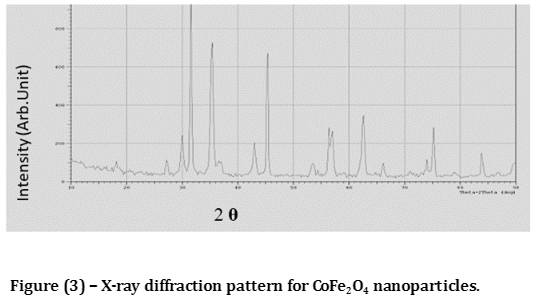Characterization of cobalt ferrite nanoparticle and evaluation its toxic effect in experimental mice
Characterization of cobalt ferrite nanoparticle and evaluation its toxic effect in experimental mice
DOI:
https://doi.org/10.21708/avb.2024.18.2.12019Resumo
This study was carried out in order to investigate the characteristics of cobalt ferrite nanoparticles in order to improve efficacy, crystalline, magnetic properties of cobalt ferrite and determine the probable toxicity of Cobalt Ferrite nanoparticles in mice. Cobalt Ferrit NPs were synthesized from an aqueous solution containing 1mg of CoFe2O4 powder dissolved in 100µl DMSO(dimethyl sulfoxide) and 4900 µlRPMI serum free media to obtain 5ml in which each ml contain 200 µg of CoFe2O4 nanoparticles.The structural features of the sample were evaluated by Fourier transform infrared spectroscopy(FTIR) and X-ray diffraction( XRD), Scanning electron microscope( SEM) which detect the surface morphology and chemical compositions, energy-dispersive X-ray spectroscopy (EDX )to determine of the micro-scale chemical structure of the sample, in vitro drug release test (IVRT) to compare between the release of the sample in acidic and neutral environments. Scherrer's formula yields an average crystallite size of 12 nm, and the lattice constant calculated from XRD data is provided according to the JCPDS (22-1086) data all the characteristic peaks in the sample are indexed as the reflection planes, match with the spinel lattice of cubic shape found in CoFe2O4 nanocrystals. The in-vivo experiments determined LD50 of CoFe2O4 and was 3000 mg/ kg bw. The toxic effects of CoFe2O4 nanoparticles have been further examined using a mouse model.It should not be hidden from view that administration CoFe2O4nanoparticles within the dosage 75 mg/ kg bw for 7 days did not cause any changes to the histological structure of the hepatic, renal, cardiac, or splenic tissues.
Downloads

Downloads
Publicado
Edição
Seção
Licença
Copyright (c) 2024 Acta Veterinaria Brasilica

Este trabalho está licenciado sob uma licença Creative Commons Attribution 4.0 International License.
Autores que publicam na Acta Veterinaria Brasilica concordam com os seguintes termos: a) Autores mantém os direitos autorais e concedem à revista o direito de primeira publicação, com o trabalho simultaneamente licenciado sob a Licença Creative Commons Attribution que permite o compartilhamento do trabalho com reconhecimento da autoria e publicação inicial nesta revista. b) Autores têm autorização para assumir contratos adicionais separadamente, para distribuição não-exclusiva da versão do trabalho publicada nesta revista (ex.: publicar em repositório institucional ou como capítulo de livro), com reconhecimento de autoria e publicação inicial nesta revista. c) Autores têm permissão e são estimulados a publicar e distribuir seu trabalho online (ex.: em repositórios institucionais ou na sua página pessoal) a qualquer ponto antes ou durante o processo editorial, já que isso pode gerar alterações produtivas, bem como aumentar o impacto e a citação do trabalho publicado (Veja O Efeito do Acesso Livre).


 Esta obra está licenciada com uma Licença
Esta obra está licenciada com uma Licença 